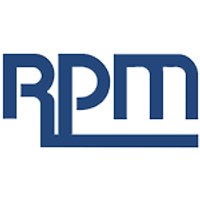
RPM International Inc
NYSE:RPM


| US |

|
Johnson & Johnson
NYSE:JNJ
|
Pharmaceuticals
|
| US |

|
Berkshire Hathaway Inc
NYSE:BRK.A
|
Financial Services
|
| US |

|
Bank of America Corp
NYSE:BAC
|
Banking
|
| US |

|
Mastercard Inc
NYSE:MA
|
Technology
|
| US |

|
UnitedHealth Group Inc
NYSE:UNH
|
Health Care
|
| US |

|
Exxon Mobil Corp
NYSE:XOM
|
Energy
|
| US |

|
Pfizer Inc
NYSE:PFE
|
Pharmaceuticals
|
| US |

|
Palantir Technologies Inc
NYSE:PLTR
|
Technology
|
| US |

|
Nike Inc
NYSE:NKE
|
Textiles, Apparel & Luxury Goods
|
| US |

|
Visa Inc
NYSE:V
|
Technology
|
| CN |

|
Alibaba Group Holding Ltd
NYSE:BABA
|
Retail
|
| US |

|
3M Co
NYSE:MMM
|
Industrial Conglomerates
|
| US |

|
JPMorgan Chase & Co
NYSE:JPM
|
Banking
|
| US |

|
Coca-Cola Co
NYSE:KO
|
Beverages
|
| US |

|
Walmart Inc
NYSE:WMT
|
Retail
|
| US |

|
Verizon Communications Inc
NYSE:VZ
|
Telecommunication
|
Utilize notes to systematically review your investment decisions. By reflecting on past outcomes, you can discern effective strategies and identify those that underperformed. This continuous feedback loop enables you to adapt and refine your approach, optimizing for future success.
Each note serves as a learning point, offering insights into your decision-making processes. Over time, you'll accumulate a personalized database of knowledge, enhancing your ability to make informed decisions quickly and effectively.
With a comprehensive record of your investment history at your fingertips, you can compare current opportunities against past experiences. This not only bolsters your confidence but also ensures that each decision is grounded in a well-documented rationale.
Do you really want to delete this note?
This action cannot be undone.

| 52 Week Range |
103.4963
140.26
|
| Price Target |
|
We'll email you a reminder when the closing price reaches USD.
Choose the stock you wish to monitor with a price alert.

|
Johnson & Johnson
NYSE:JNJ
|
US |

|
Berkshire Hathaway Inc
NYSE:BRK.A
|
US |

|
Bank of America Corp
NYSE:BAC
|
US |

|
Mastercard Inc
NYSE:MA
|
US |

|
UnitedHealth Group Inc
NYSE:UNH
|
US |

|
Exxon Mobil Corp
NYSE:XOM
|
US |

|
Pfizer Inc
NYSE:PFE
|
US |

|
Palantir Technologies Inc
NYSE:PLTR
|
US |

|
Nike Inc
NYSE:NKE
|
US |

|
Visa Inc
NYSE:V
|
US |

|
Alibaba Group Holding Ltd
NYSE:BABA
|
CN |

|
3M Co
NYSE:MMM
|
US |

|
JPMorgan Chase & Co
NYSE:JPM
|
US |

|
Coca-Cola Co
NYSE:KO
|
US |

|
Walmart Inc
NYSE:WMT
|
US |

|
Verizon Communications Inc
NYSE:VZ
|
US |
This alert will be permanently deleted.
 RPM International Inc
RPM International Inc
RPM International Inc
Investor Relations
RPM International Inc., with roots tracing back to 1947, has evolved into a powerhouse in the coatings, sealants, and specialty chemicals industry. The company was founded by Frank C. Sullivan, father of the current chairman, and has steadily grown into a global entity by adopting a diverse portfolio strategy. At the heart of RPM's operations is the commitment to innovation and quality, which drives its business segments: consumer, industrial, and specialty. In the consumer market, brands like Rust-Oleum and DAP are household names, delivering reliable performance for home improvement projects. RPM doesn’t merely rest on its legacy brands; it continually reinforces its market presence through strategic acquisitions, each chosen to complement its broad spectrum of products and enhance operational synergies.
Revenue flows from RPM's astute balance of scale and specialization. The industrial segment caters to large-scale end-users, supplying protective coatings and roofing systems vital for infrastructure durability. Meanwhile, the specialty segment delves into high-performance products used in niche markets, from marine coatings to edible coatings for the food industry. The company's financial stability and growth are underpinned by its decentralized yet interconnected business model, where individual brands operate with entrepreneurial leeway while leveraging central resources for maximum efficiency. This strategic structure allows RPM to innovate swiftly, meet niche market demands, and maintain steady cash flows amid varying economic climates, ensuring it remains a stalwart in an industry cornered by material giants.

RPM International Inc., with roots tracing back to 1947, has evolved into a powerhouse in the coatings, sealants, and specialty chemicals industry. The company was founded by Frank C. Sullivan, father of the current chairman, and has steadily grown into a global entity by adopting a diverse portfolio strategy. At the heart of RPM's operations is the commitment to innovation and quality, which drives its business segments: consumer, industrial, and specialty. In the consumer market, brands like Rust-Oleum and DAP are household names, delivering reliable performance for home improvement projects. RPM doesn’t merely rest on its legacy brands; it continually reinforces its market presence through strategic acquisitions, each chosen to complement its broad spectrum of products and enhance operational synergies.
Revenue flows from RPM's astute balance of scale and specialization. The industrial segment caters to large-scale end-users, supplying protective coatings and roofing systems vital for infrastructure durability. Meanwhile, the specialty segment delves into high-performance products used in niche markets, from marine coatings to edible coatings for the food industry. The company's financial stability and growth are underpinned by its decentralized yet interconnected business model, where individual brands operate with entrepreneurial leeway while leveraging central resources for maximum efficiency. This strategic structure allows RPM to innovate swiftly, meet niche market demands, and maintain steady cash flows amid varying economic climates, ensuring it remains a stalwart in an industry cornered by material giants.





























 You don't have any saved screeners yet
You don't have any saved screeners yet
